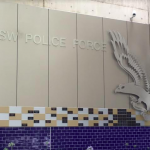The Offence of Tampering with Evidence in New South Wales

A Senior Constable with the New South Wales Police Force has pleaded not guilty to five charges in the Downing Centre Local Court, including tampering with evidence with intent to mislead a judicial tribunal, doing an act intending to pervert the course of justice and modifying restricted data held in computer, and two counts of common assault.
The charges are the result of an arrest in May 2019, of a Sydney woman Anya Bradford who had been asked for her identification in the gaming room of the Golden Fleece Hotel.
The court heard that when approached, Ms Bradford told officers she did not have ID and walked towards the door. CCTV footage from the venue shows Senior Constable Mark Follington grabbing the woman’s arm, and a scuffle between the two of them follows.
Ms Bradford told the court that officers then slammed her head into a nearby ATM machine ‘several times.’
Police officer changes his story
Ms Bradford was tasered twice by Constable Brown, a junior police officer accompanying his superior.
Constable Brown initially provided a statement to the effect that he used a taser against Ms Bradford during a physical altercation between her and his superior, saying he was concerned for the safety of officer Follington.
The statement was consistent with that of Follington, whose statement also stated that the taser was used after the altercation became physical.
However, CCTV played in court told a very different story – showing that the junior actually tasered the woman in the absence of any aggression shown by the woman let alone any physical altercation.
Having see the footage in court, Constable Brown changed his testimony and agreed that Ms Bradford did not exhibit aggression and that the tasering occurred in the absence of any physical altercation.
The junior officer then proceeded to testify about his concerns regarding a conversation between him and Follington on the night of the incident, saying he was uncomfortable with the version of events entered into the police computer by his senior.
The court that after the encounter, Ms Bradford fled the scene but was pepper sprayed, kicked, handcuffed and dragged from the scene by the officers when they caught up with her.
Like many others who are assaulted by police, the woman was then charged with assaulting an officer in execution of duty in contravention of section 60 of the Crimes Act 1900 and resisting arrest under section 546C, and spent the night in police custody.
However, the charges against her were withdrawn and dismissed following an internal police investigation, and it is now Officer Follington who is facing the music.
The charges against the Senior Constable
Officer Follington is facing two assault charges as well as:
- Tampering with evidence under section 317 of the Crimes Act 1900,
- Perverting the course of justice under section 319 of the Crimes Act 1900, and
- Unauthorised access to, or modification of, restricted data under section 308H of the Crimes Act 1900.
The offence of evidence tampering
Tampering with evidence is an offence under section 317 of the Crimes Act 1900 which carries a maximum penalty of 10 years in prison.
To establish the offence, the prosecution must prove beyond reasonable doubt that:
- You suppressed, concealed, destroyed, altered or falsified information knowing it is or may be required as evidence in a judicial proceeding, or
You fabricated false evidence (other than by perjury), or
You knowingly made use of false evidence, and
- You intended by doing so to mislead any judicial tribunal in judicial proceedings
A ‘judicial proceeding’ is any proceeding in or before a judicial tribunal
In which evidence may be taken on oath.
A ‘judicial tribunal’ is any person, including a coroner or arbitrator, or any court or other body authorised by law or by the consent of parties which may conduct a hearing to determine any matter or thing.
The offence of perverting the course of justice
Perverting the course of justice is an offence under section 319 of the Crimes Act 1900, which carries a maximum penalty of 14 years in prison.
To establish the offence, the prosecution must prove beyond reasonable doubt that:
- You engaged in an act or made an omission, and
- By that act or omission, you intended to pervert the course of justice
Section 312 of the Act defines perverting the course of justice as, ‘obstructing, preventing, perverting or defeating the course of justice or the administration of law’.
Examples of the offence include:
- Attempting to bribe a police or judicial officer to avoid being prosecuted or punished,
- Falsely swearing or declaring that another person was responsible for an offence,
- Using another’s phone or email to manufacture a defence to a crime, and
- Encouraging or bribing another person to plead guilty to a crime they did not commit, or to provide a false alibi, or give false testimony in court.
The offence of accessing or modifying restricted data without authorisation
Unauthorised access to data held in a computer is an offence under section 308H of the Crimes Act 1900 which carries a maximum penalty of 2 years in prison
To establish the offence, the prosecution must prove beyond reasonable doubt that:
- You accessed or modified restricted data without authorisation
- You intended to cause that access or modification, and
- You knew the access or modification was unauthorised
‘Restricted data’ is that which is held in a computer and restricted by an access control system
‘Access’ is defined as:
- Displaying the data,
- Copying or moving the data, or
- Executing a program.
‘Modify’ is defined as:
- Altering or removing the data, or
- Adding to the data.
Access is ‘unauthorised’ if you are not entitled to effect it.
Defences to the charges
In addition to having to prove each of the above ‘essential elements’ (or ingredients) of the offences beyond reasonable doubt, the prosecution must negative beyond reasonable doubt any legal defences that are validly raised on the evidence.
These defences include:
- Duress,
- Necessity, and
- Self-defence
Going to court for a criminal offence?
If you have been charged with a criminal offence under the Crimes Act 1900, call Sydney Criminal Lawyers anytime on 9261 8881 to arrange a free first conference with an experienced, specialist criminal defence lawyer who will advise you of your options, the best way forward and fight for the optimal outcome.








